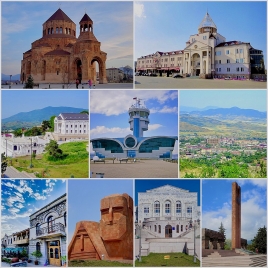Stepanakert
Wednesday, February 16, 2022
Stepanakert is the de facto capital and the largest city of the Republic of Artsakh. The city is located in a valley on the eastern slopes of the Karabakh mountain range, on the left bank of the Qarqarchay river.
The area that would become Stepanakert was originally an Armenian settlement named Vararakn. During the Soviet period, the city was made the capital of the Nagorno-Karabakh Autonomous Oblast, becoming a hub for economic and industrial activity. In addition, the city became a hotbed for political activity, serving as the center for Armenian demonstrations calling for the unification of Nagorno-Karabakh with Armenia. Stepanakert suffered extensive damage following the dissolution of the Soviet Union and the outbreak of the First Nagorno-Karabakh War and passed into the hands of local Armenians with the establishment of the Republic of Artsakh.
The city is a regional center of education and culture, being home to Artsakh University, musical schools, and a palace of culture. The economy is based on the service industry and has varied enterprises, food processing, wine making, and silk weaving being the most important. As of 2021, the population of Stepanakert is 75,000.
Medieval Armenian sources attest to a settlement in the locale called Vararakn. Vararakn remained the local Armenian name for the town until 1923.
The town was renamed Stepanakert ("the city of Stepan") in 1923, after Armenian Bolshevik revolutionary Stepan Shahumian. The name is formed from the words Stepan (Armenian: Ստեփան) and "kert" (Armenian: կերտ, meaning "created").
First Nagorno-Karabakh War and independence
The political and economic reforms that General Secretary Mikhail Gorbachev undertook in 1985 saw a marked decentralization of Soviet authority. Armenians, in both the Armenian SSR and Nagorno-Karabakh, viewed Gorbachev's reform program as an opportunity to unite the two together. On 20 February 1988, tens of thousands of Armenians gathered to demonstrate in Stepanakert's Lenin Square (now Renaissance Square) to demand that the region be joined to Armenia. On the same day, the Supreme Soviet of Nagorno-Karabakh voted to join the Armenian SSR, a move strongly opposed by the Soviet Azerbaijani authorities.
Relations between Stepanakert's Armenians and Azerbaijanis, who supported the Azerbaijani government's position, deteriorated in the following years. Inter-ethnic strife in the city in September 1988, encompassing physical attacks and burning of property, forced nearly all Azerbaijanis to flee the city. The Soviet Army took up positions in the city and announced a curfew three days later. In 1990 the army dispatched special forces units and various other elements to Stepanakert in order to prevent its takeover by Azerbaijani forces.
After Azerbaijan declared its independence from the Soviet Union in 1991, Stepanakert was renamed Khankendi by the Azerbaijani government. Fighting broke out over control of Nagorno-Karabakh, which, after three years of war, resulted in Armenian control of the region and a connecting corridor to Armenia to the west. Prior to the conflict, Stepanakert was the largest city of the NKAO, with a population of 70,000 out of a total 189,000 (Armenians at the time comprised 75% of the region's total population). By early 1992, that figure had dropped to 50,000.
During the war, the city suffered immense damage from Azerbaijani bombardment, especially in early 1992 when the Azerbaijanis positioned BM-21 Grad rocket artillery in Shusha and rained down missiles over Stepanakert. A journalist for Time noted in an April 1992 article that "scarcely a single building escaped damage in Stepanakert." It was not until 9 May 1992, with the capture of Shusha, that the ground bombardment ceased. The city, nevertheless, continued to suffer aerial bombardment until the end of the war. As a result, the majority of the city was in a severely damaged state. As of 2016, the city had not been completely restored from the war.
The city came under intense bombardment once again during the 2020 Nagorno-Karabakh war. Residential areas were continuously hit by the Azerbaijani Army with cluster munitions throughout the war, starting on the first day of fighting, and residents were urged to use the city's bomb shelters. As Azerbaijani forces advanced on the city of Shusha, the Lachin corridor was shut down by Artsakh authorities.
With Azerbaijani forces 15 kilometers from the capital, a ceasefire agreement was signed on 10 November. As part of the agreement, Russian peacekeepers were deployed to the region. Following the war, the population of Stepanakert swelled to 75,000 residents as a result of some 10,000 to 15,000 displaced people who lost their homes elsewhere in the Republic of Artsakh during the war.
Religion
The late-19th-century church of Vararakn was destroyed in the 1930s to build the Stepanakert Drama Theatre. Throughout the rest of the Soviet era, there were no traditional churches in Stepanakert, although most of the population of the city were members of the Armenian Apostolic Church.
The church of Surp Hakob (or Saint James) was opened in 2007; it remained the only open church in the city until 2019. The church was financed by Nerses Yepremian from Los Angeles. The church was consecrated on 9 May 2007, in honor of the 15th anniversary of the capture of Shusha by Armenian forces.
The construction of the Holy Mother of God Cathedral was launched on 19 July 2006. The cost of the project was expected to be around US$2 million and the architect of the church is Gagik Yeranosyan. However, the construction process was slow due to a lack of financial resources. The inauguration of the church was expected to take place in September 2016. Construction finished and the church was opened in 2019.
There is a small community of Armenian Evangelicals with around 500 members. The only Armenian evangelical church in Artsakh is located in Stepanakert. The Evangelical community supports many schools, hospitals and other institutions through the help of the Armenian Diaspora.





